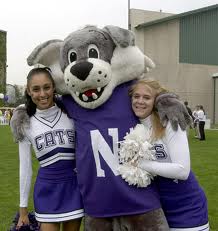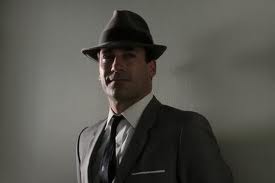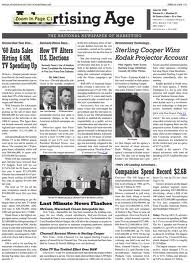By allowing live sex act into curriculum, did Northwestern University screw its brand?
March 4, 2011

Northwestern Wildcat…or Horndog?
And so we come to the live sex demonstration that took place at Northwestern University following Prof. J. Michael Bailey’s popular “Human Sexuality” class. By now you must know the lurid details. To dramatize the world of kink and fetish, a man penetrated his fiancé with a jerry-rigged reciprocating saw (or Sawzall) in front of some 100 students. If you haven’t heard the story then after cleaning the coffee you just spit on your computer’s keyboard, here is the coverage from the Chicago Sun Times. And from the Chicago Tribune. I’m not going to editorialize one way or the other. I simply don’t know all the, um, ins and outs of this story to put it into context. I understand no laws were broken. The participants were adults. I’m guessing the students were too. It was on the syllabus.
Like most of you, I was flabbergasted by the story and a little titillated. Certainly, because of the subject matter but also because it took place at Northwestern University. Forever, Northwestern has been considered the brainiest school in the Big Ten, sort of the conference’s answer for the Ivy League. With its beautiful and swanky North Shore location (Lake Michigan to the East, stately mansions to the West), it certainly looks the part. In addition, the institution regularly tops out in all metrics related to superb education. Including admission criteria and costs. Even so, it only admits 20% of applying freshmen. To go there is a privilege. Here is where my wife and I –gulp- hoped to send our three daughters one day.
Prestige at a price. That’s not the University’s tagline but, in frankness, that’s the brand. Maintaining a brand like Northwestern’s takes a fine mixture of conservative stewardship and progressive leadership. Negotiating this dichotomy is critical. Mom and Dad want the former. The kids want the latter. There are other targets worth mentioning: alma mater, perspective employers, partner schools and institutions. In the end, it’s not easy getting it right. For over 150 years, Northwestern has done so masterfully.

And then out came the “fucksaw.”
Putting aside all the different hats I wear as a man (father, husband, lover, guardian), what is my position as an advertising man? For better or for worse, the brand got done to it what was done to the woman on stage. Some may view the episode as an example of fearless education in a modern world. Others will likely see it as an awful, awful mistake. Frankly, I’m leaning on the latter. Despite my fervent belief in a liberal arts education, I can’t help but think this was a bad move. When the inevitable video comes out millions of people will experience the brand as if it were nothing less than an episode on You Porn.
The school’s color is purple and a deeper shade now.
Special note: The male in the sex act is a Group Creative Director at Tribal DDB, an advertising agency in Chicago. He is about to become a lot more famous. Let’s hope his clients aren’t too conservative. Wishful thinking I’m afraid.
Angels and Kings and Bears, oh my! Is racial profiling black sheep version of target marketing?
November 3, 2010

Angels & Kings. So nice and white.
Last week a group of Chicago Bears were denied entry into the Angels & Kings nightclub in Chicago. Apparently, they were told the club was already being leased for the night and that they were not welcome.
You know where this is going.
By next morning it was all over the Internet and in the press. The primary question was did the club deny entrance to the group because it was comprised of mostly black men? The fact that these guys were famous athletes made the story even more provocative. You’d think they’d want celebrities in the club.
In fairness to Angels & Kings, which is partially owned by Pete Wentz of Fallout Boy (ugh!), another entity was leasing the club that night. In addition, not all the players denied entry were black. And, finally, according to eyewitness accounts, several rejected Bears didn’t seem to give a shit. They would take their copious wads of money (arguably undeserved this year) to some other overrated club in Chicago’s touristy River North district, which is exactly what they did.
Still, the accusations of racial profiling by the club came fast and furious. Sorry, Mr. Wentz, but the “fallout” was brutal. Actually, it’s still going on. Inquiries are being made. The usual denials, rebuttals and arguments…
Why am I writing about racial profiling? Because not only is it disturbing and fascinating but to me it feels awfully similar to target marketing. An advertiser (Angels & Kings) targets a specific group (white men and women) to embrace his brand (upscale & hip), forsaking all others (blacks and other minorities). In fact, one could argue that maintaining the brand’s equity actually requires the brand manager to forsake all others.
Calm down. I’m not a hater; I’m just turning around an argument and framing it in the context of marketing.
But take this truth and suck on it: racial profiling occurs in every club with a gated entrance, bouncer, and cover charge. That’s what the rope is for: Keeping. People. Out.
I’ve spoken to several influential club owners in this town and they all freely admit to racially profiling customers. Furthermore, they claim it’s standard operating procedure. One told me his business wouldn’t succeed if it operated more democratically. How do they get away with it? The easiest trick is invoking a dress code. If an owner doesn’t want you in his club he needs only to find something inappropriate about your wardrobe. This happens all the time. Is it a racist agenda or is the proprietor just trying to protect his brand?
And it’s not just African-Americans getting “blacklisted.”
Recently, a popular club in Chicago’s so-called Viagra triangle became “overrun” with young Indians. According to the owner they were an invasive species, crowding out the regular customers. Via arbitrary dress codes and made up private parties, the bar’s owner began turning them away in droves. It worked. The “locusts” moved on to another field. His words not mine.
What do you think? Does a brand have a right to choose its customers? What about the age-old practice of charging men a cover but not women? Is that prejudiced? If so, where’s the uproar? Before answering any of these questions, ask yourself what you would do if, for example, you owned a club and your regular customers stopped coming in because another group was. Maybe you’re not so liberal in your own back yard.
Euro RSCG hits Michigan Avenue on behalf of Off The Street Club.
September 24, 2009

For those unawares, each year a different Chicago advertising agency gets behind Off The Street Club, creating marketing, fund raising materials, and doing whatever it can to further the club’s most worthwhile agenda. This was Euro RSCG’s year.
Last week I told you about our opening salvo on behalf of the club, a website, offthestreetclub.org we built in conjunction with eatdrink.com. It’s pretty sweet. If you haven’t done so already have a look. By the way, the logo we created is featured above. Our theme: Get a kid off the street and on to so much more.
And Friday, September 25th that’s exactly what we’re going to do! Our agency will be at Pioneer Court in front of the Tribune Tower on Michigan Avenue hosting a barnburner of a fundraising event. We had dozens of life-size cardboard cutouts made of some of the 400 children at OTSC. They will be set up on a makeshift street representing the hardscrabble west side of Chicago. We’re going to beseech pedestrians to literally remove a child from the street and bring him or her to safety, after which the good citizen can make a donation.
Between the website and events like this, our fantasy is to raise $1 million dollars ten bucks at a time. While that’s not likely going to happen, to paraphrase Leo Burnett: “we won’t come up with a handful of mud either.”
To that end, for anyone who donates $100 dollars or more I’ll happily provide a signed copy of my novel, The Happy Soul Industry.. If he or she doesn’t want that, I’ll give ’em a hug!
Either way, come on out and help us get kids off the street and on to so much more.






 The Happy Soul Industry
The Happy Soul Industry The Last Generation
The Last Generation